HUMAN RIGHTS AND DUTIES
Paper – II
Note : This paper contains fifty (50) objective type questions of two (2) marks each. All questions are compulsory.
1. According to Kautilya which one is NOT covered in the concept of Dharma ?
(1) Worship of God in the open
(2) Speaking of Truth
(3) Close relation of dharma with politics
(4) Effective method of controlling the King
2. Which one of the following is NOT a crime under the statute of the International Criminal Court ?
(1) Genocide
(2) War Crimes
(3) Crimes against humanity
(4) Crimes against peace
3. “Annihilation of caste” is a famous essay authored by
(1) Jyotiba Phule
(2) Narayan Guru
(3) Mahatma Gandhi
(4) B.R. Ambedkar
4. Which Section of the Protection of Human Rights Act, 1993 provides for specifying Human Rights Courts ?
(1) Article 3
(2) Article 21
(3) Article 30
(4) Article 31
5. Who among the following was a member of International Commission on Human Security ?
(1) Dr. Nagendra Singh
(2) Dr. B.N. Rau
(3) Arundhati Ghosh
(4) Prof. Amartya Sen
6. Who was the Prime Minister of India when the Terrorist and Destructive Activities Act (TADA) was passed ?
(1) Smt. Indira Gandhi
(2) Rajiv Gandhi
(3) V.P. Singh
(4) Chandrashekhar
7. Who was the Home Minister in Indian Government who had piloted the Armed Forces Special Power Bill in 1958 ?
(1) G.B. Pant
(2) Morarji Desai
(3) Atulya Ghosh
(4) P.C. Sen
8. Which of the following two principles of democracy were criticised by Habermas in his book – ‘Between Facts and Norms’ ?
(1) Liberal and Republican
(2) Parliamentary and Liberal
(3) Neo-Liberal and Republican
(4) Presidential and Republican
9. Which of the following is not a provision of Code of Criminal Procedure (now known as Cr.P.C. 1973) ?
(1) The arrested person shall not be subjected to be more restraint than is necessary to prevent his escape.
(2) He/she is to be examined by a registered medical practitioner.
(3) He/she is to be informed of grounds of arrest and of right to veil.
(4) In case of female search may be made by male but with strict regard to decency.
10. The author of Green Political Theory is
(1) Robert Guddin
(2) Guttman and Thomson
(3) Waldron
(4) Kraimer
11. Who among the following has a Dalit perspective of human rights ?
(1) Gandhi
(2) Nehru
(3) Phule
(4) Amartya Sen
12. Which article of Indian Constitution provides that articles 20 and 21 shall not be suspended during the period of emergency ?
(1) Article 355
(2) Article 357
(3) Article 358
(4) Article 359
13. Under the Criminal Procedure Code (CrPC) of India certain rights on arrest are provided.
Which among the following is NOT recognized as a right ?
(1) Right to be informed of the grounds for the arrest in a language which, one understands.
(2) Right to be released on bail in case of a bailable offence.
(3) Right not to be handcuffed.
(4) Right to have access to a lawyer of one’s choice.
14. The principle of self-determination has been incorporated in the charter of United Nations under
(1) Article 2(7)
(2) Article 1(2), 55 and 56
(3) Article 5
(4) Article 6
15. The General Assembly of the United Nations created the office of UN High Commissioner for Human Rights in the year
(1) 2006
(2) 1993
(3) 1994
(4) 1995
16. Employment of children in any factory, mine or other hazardous work in prohibited under which Article of the Constitution of India ?
(1) Article 17
(2) Article 22
(3) Article 23
(4) Article 24
17. Identify the Supreme Court judge who is associated with the origin of Public Interest Litigation ?
(1) Justice P.N. Bhagvati
(2) Justice H.R. Khanna
(3) Justice J.S. Verma
(4) Justice Fatima Beevi
18. Which of the following is not a Fundamental Right under Article 19 of the Constitution of India ?
(1) To form associations or unions
(2) To practice any profession
(3) To carry on any occupation, trade or business
(4) To acquire, hold and dispose of property
19. Provision for early childhood care and education to children below the age of six years is specified in which Article of the Constitution ?
(1) Article 21
(2) Article 21-A
(3) Article 41
(4) Article 45
20. The phrase Economico-Corporative was used by
(1) Rosa Luxemberg
(2) Habermas
(3) Gramsci
(4) Thoreau
Question Nos. 21 – 30 contain two statements one labelled as Assertion (A) and the other as Reason (R). Examine whether the statements are correct and related to each other with the help of the code given below :
21. Assertion (A) : Child labour is the largest in India among the world.
Reason (R) : India has one of the largest population in the world.
Codes :
(1) Both (A) and (R) are correct and (R) is the correct explanation of (A).
(2) Both (A) and (R) are correct, but (R) is not the correct explanation of (A).
(3) (A) is correct, but (R) is incorrect.
(4) (A) is incorrect, but (R) is correct.
22. Assertion (A) : India will remain a secular state as long as the present Constitution remains.
Reason (R) : The Supreme Court has interpreted secularism as part of the basic structure of the Constitution which cannot be amended.
Codes :
(1) Both (A) and (R) are correct and (R) is the correct explanation of (A).
(2) Both (A) and (R) are correct, but (R) is not the correct explanation of (A).
(3) (A) is correct, but (R) is incorrect.
(4) (A) is incorrect, but (R) is correct.
23. Assertion (A) : Bonded or forced labour is not permissible in India.
Reason (R) : Constitution prohibits it and is made punishable according to law.
Codes :
(1) Both (A) and (R) are correct and (R) is the correct explanation of (A).
(2) Both (A) and (R) are correct, but (R) is not the correct explanation of (A).
(3) (A) is correct, but (R) is incorrect.
(4) (A) is incorrect, but (R) is correct.
24. Assertion (A) : Women in Indian Society is largely exploited.
Reason (R) : In India women are largely uneducated and not self employed.
Codes :
(1) Both (A) and (R) are correct and (R) is the correct explanation of (A).
(2) Both (A) and (R) are correct, but (R) is not the correct explanation of (A).
(3) (A) is correct, but (R) is incorrect.
(4) (A) is incorrect, but (R) is correct.
25. Assertion (A) : The child sexual abuse is common in the Indian society recently inspite of stringent laws against it.
Reason (R) : Laws are either not enforced properly or become ineffective because of cultural reasons or lack of sex education.
Codes :
(1) Both (A) and (R) are correct and (R) is the correct explanation of (A).
(2) Both (A) and (R) are correct, but (R) is not the correct explanation of (A).
(3) (A) is correct, but (R) is incorrect.
(4) (A) is incorrect, but (R) is correct.
26. Assertion (A) : Freedom of the press and other media is a Fundamental Right in India.
Reason (R) : The Supreme Court has interpreted press and the media as part of the fundamental right to freedom of speech and expression.
Codes :
(1) Both (A) and (R) are correct and (R) is the correct explanation of (A).
(2) Both (A) and (R) are correct, but (R) is not the correct explanation of (A).
(3) (A) is correct, but (R) is incorrect.
(4) (A) is incorrect, but (R) is correct.
27. Assertion (A) : Globalization has only widened gender disparity and increased feminisation of poverty.
Reason (R) : The globalization has taken away whatever control women has over traditional occupations and better avenues of employment.
Which of the following is correct ?
Codes :
(1) Both (A) and (R) are correct and (R) is the correct explanation of (A).
(2) Both (A) and (R) are correct, but (R) is not the correct explanation.
(3) (A) is correct, but (R) is wrong.
(4) (A) is wrong and (R) is correct.
28. Assertion (A) : Despite anti-dowry legislation in India, a conspicuous increase in dowry has been witnessed.
Reason (R) : Dowry in the larger sense refers to cost of wedding celebrations and rituals, gifts, the property or cash demands made by the groom’s family.
Which one of the following is correct ?
Codes :
(1) Both (A) and (R) are true and (R) is the correct explanation of (A).
(2) Both (A) and (R) are true, but (R) is not the correct explanation of (A).
(3) (A) is true and (R) is false.
(4) (A) is false, but (R) is true.
29. Assertion (A) : Human Rights NGOs “name and shame” states which are involved in gross violations of human rights. They critically evaluate their record of human rights.
Reason (R) : Many NGOs are fraud and not contributing towards promotion of human rights.
Codes :
(1) Both (A) and (R) are correct and (R) is the correct explanation of (A).
(2) Both (A) and (R) are correct, but (R) is not the correct explanation of (A).
(3) (A) is correct, but (R) is incorrect.
(4) (A) is incorrect, but (R) is correct.
30. Assertion (A) : A judge of the Supreme Court shall not be removed from his office except by an order of the President after following the impeachment procedure prescribed under the Constitution of India for proved misbehaviour or incapacity.
Reason (R) : The above guarantee is necessary for protecting the independence of the judiciary and protection of the human rights.
Codes :
(1) Both (A) and (R) are correct and (R) is the correct explanation of (A).
(2) Both (A) and (R) are correct, but (R) is not the correct explanation of (A).
(3) (A) is correct, but (R) is incorrect.
(4) (A) is incorrect, but (R) is correct.
From question No. 31 – 40 match List – I with List – II and select the correct answer with the help of codes given below :








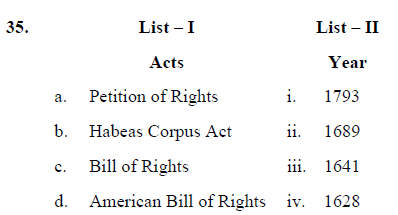
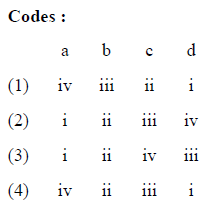
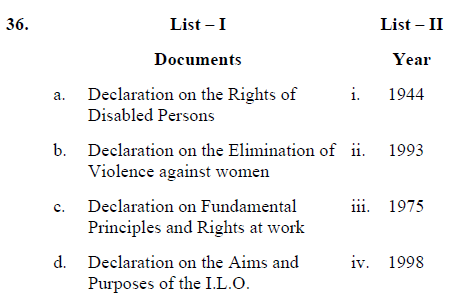
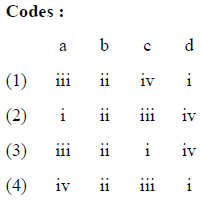





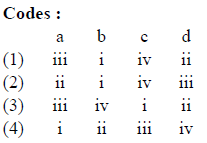


41. Identify the correct sequence of following treaties/conventions/optional protocols with the help of the codes given below :
(i) Supplementary convention on the Abolition of Slavery, the Slave Trade and Institutions and Practices similar to slavery.
(ii) Convention relating to the status of Refugees.
(iii) Convention on the Political Rights of Women.
(iv) Optional Protocol to convention on the Rights of the Child on the sale of children, child prostitution and child pornography.
Codes :
(1) (ii), (iii), (i), (iv)
(2) (iv), (iii), (ii), (i)
(3) (i), (ii), (iii), (iv)
(4) (iii), (iv), (ii), (i)
42. Arrange the following books in chronological order of their publication and choose the correct answer from the codes given below :
(i) John Locke’s Second Treatise of Government
(ii) J.S. Mill’s Essay on Liberty
(iii) Virginia Wolf’s A Room of One’s Own(iv)
Betty Friedan’s Famine Mystique
Codes :
(1) (i), (ii), (iii), (iv)
(2) (iv), (iii), (ii), (i)
(3) (iii), (ii), (i) (iv)
(4) (ii), (i), (iv), (iii)
43. Arrange the following Supreme Court cases on the right to education according to the chronological order and choose the correct answer from the codes below :
(i) Mohini Jain case
(ii) T.M.A. Pai (II) case
(iii) Islamic Educational Foundation case
(iv) Pragati Educational Cultural Trust case
Codes :
(1) (i), (ii), (iv), (iii)
(2) (i), (ii), (iii), (iv)
(3) (ii), (i), (iii), (iv)
(4) (ii), (i), (iv), (iii)
44. Arrange the following in the chronological order and choose the correct answer from the codes below :
(i) The Dowry Prohibition Act
(ii) Protection of Women Against Domestic Violence Act
(iii) The Equal Remuneration Act
(iv) The Pre-Natal Diagnostic Techniques Act
Codes :
(1) (i), (ii), (iii), (iv)
(2) (iii), (i), (iv), (ii)
(3) (i), (iii), (iv), (ii)
(4) (iii), (i), (ii), (iv)
45. Arrange the following in the chronological order and choose the correct answer from the codes below :
(i) Introduction of provisions for Panchayats and municipalities in the Constitution of India.
(ii) Introduction of Article 21-A in the Constitution.
(iii) Introduction of Fundamental Duties in the Constitution.
(iv) 44th Amendment of the Constitution making Articles 20 and 21 beyond the power of suspension even during emergency.
Codes :
(1) (i), (ii), (iii), (iv)
(2) (iii), (i), (ii), (iv)
(3) (iv), (iii), (ii),
(i) (4) (iii), (iv), (i), (ii)
46. Arrange the following in chronological order and choose the correct answer with the help of codes given below :
(i) Body of principles for the protection of all persons under any form of detention or imprisonment.
(ii) Convention on the Rights of the child.
(iii) Declaration on the Rights of persons belonging to National or Ethnic, Religious and Linguistic minorities.
(iv) Vienna Declaration (Human Rights and Fundamental Freedom are the birth right of all).
Codes :
(1) (i), (ii), (iii), (iv)
(2) (iv), (iii), (ii), (i)
(3) (iv), (i), (ii), (iii)
(4) (iii), (ii), (i), (iv)
47. Arrange the following in chronological order and choose the correct answer with the help of codes given below :
(i) United Nations Environment Programme (UNEP)
(ii) United Nations Volunteers (UNV)
(iii) United Nations Population Fund (UNFPA)
(iv) United Nations Conference on Trade and Development (UNCTAD)
Codes :
(1) (i), (ii), (iii), (iv)
(2) (iv), (iii), (ii), (i)
(3) (i), (iv), (iii), (ii)
(4) (ii), (iii), (iv), (i)
48. When are the meeting of Mahila Sabha organised in Gram Panchayat ?
(1) Before the meetings of Gram Sabha.
(2) After the meetings of Gram Sabha.
(3) Its meetings are held simultaneously with those of Gram Sabha.
(4) Any time its meetings can be invited.
49. Arrange the following books in chronological order of their publication and choose the correct answer from the codes below :
(i) Sexual Politics by Kate Millet
(ii) The Second Sex by Simone de Beauvoir
(iii) A Vindication of the Rights of Women, by Mary Wollstonecraft
(iv) Rights of Man by Thomas Paine
Codes :
(1) (ii), (i), (iv), (iii)
(2) (iii), (iv), (i), (ii)
(3) (i), (ii), (iv), (iii)
(4) (iv), (iii), (ii), (i)
50. Arrange the following in the chronological order and choose the correct answer from the codes below :
(i) Protection of Human Rights Act
(ii) The Environment (Protection) Act
(iii) National Commission for Women Act
(iv) National Commission for Scheduled Caste Act
Codes :
(1) (i), (ii), (iii), (iv)
(2) (ii), (iii), (i), (iv)
(3) (ii), (i), (iv), (iii)
(4) (i), (ii), (iv), (iii)
Latest Govt Job & Exam Updates: